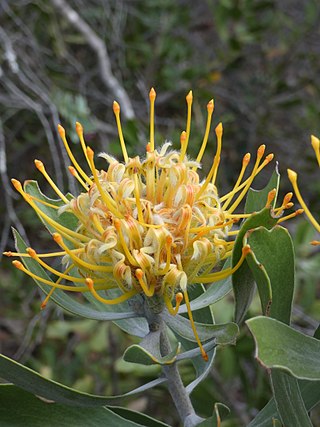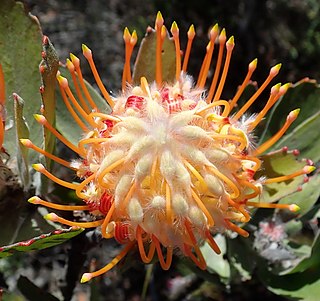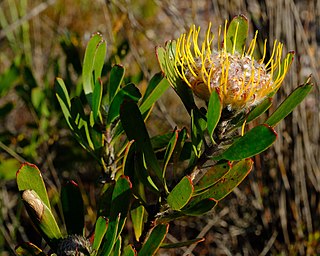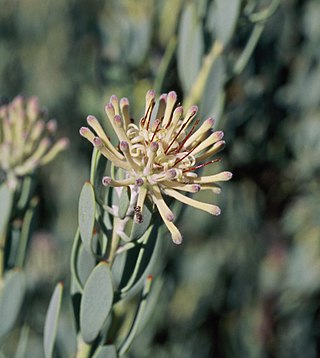
Leucospermum is a genus of evergreen upright, sometimes creeping shrubs that is assigned to the Proteaceae, with currently forty-eight known species.

Leucospermum cuneiforme is an upright evergreen shrub with many pustules growing on the lower branches, wedge-shaped leaves, and oval, initially yellow flower heads that later turn orange, with long styles sticking far beyond the perianths, jointly giving the impression of a pincushion. It is called wart-stemmed pincushion in English and luisiesbos (lice-bush) in Afrikaans. The species is common in the southern mountains of South Africa.

Leucospermum muirii is a rounded, upright, evergreen shrub of about 1+1⁄2 m (4.9 ft) high, with a single trunk at its base, that is assigned to the Proteaceae. The flowering branches are 2–3 mm (0.079–0.118 in) thick and are initially grey due to a covering of fine crinkly hairs, which are soon lost. The very narrow spade-shaped leaves of about 5 cm (2.0 in) long and 3⁄4 cm (0.30 in) wide carry three to seven teeth, and also quickly lose their soft layer of hairs. Its smallish globe-shaped flower heads of 2–3 cm (0.79–1.18 in) in diameter occur with one to four together, each on a stalk of 1–2 cm (0.39–0.79 in) long. It has pale to greenish yellow flowers, becoming orange with age, with some long hairs near their tips, from which straight styles stick out. This gives the flower head the likeness of a pincushion. It flowers from July till October and is pollinated by birds. It is called Albertinia pincushion in English and bloukoolhout in Afrikaans. It is an endemic species that can only be found near Albertinia in the very south of the Western Cape province of South Africa.

Leucospermum praecox is an evergreen, rounded, upright shrub of up to 3 m (9 ft) high, and 4 m (12 ft) in diameter that is assigned to the family Proteaceae. It has hairless, inverted egg-shaped to broadly wedge-shaped leaves of about 5 cm (2 in) long with six to eleven teeth near the tip, globe-shaped flower head with initially yellow flowers, later orange or scarlet, with styles sticking far out, giving the head the appearance of a pincushion. It is called Mossel Bay pincushion or large-tufted pincushion in English. It flowers between April and September. It is an endemic species that is restricted to the very south of the Western Cape province of South Africa.

Leucospermum gueinzii is an evergreen, upright shrub of 2–3 m (6–9 ft) high from the family Proteaceae. It has pointy lance-shaped to elliptic, eventually hairless, mostly entire leaves and egg-shaped, later flatter flower heads of about 12 cm in diameter, containing initially deep orange, later crimson flowers. From the center of each flower emerges a long style with a thickened tip, giving the entire head the appearance of a pincushion. Its flowers can be found between August and December. It is called kloof fountain-pincushion or shorter kloof pincushion in English. This is an endemic species restricted to a very small area near the south coast of the Western Cape province in South Africa.

Leucospermum grandiflorum is an evergreen, upright shrub of up to 2½ m high that is assigned to the family Proteaceae. It has elliptic, greyish green, softly hairy leaves and initially egg-shaped heads with yellow flowers, later flatter with flowers turning orange. From the center of each flower emerges a long pale yellow style with a pink thickened tip that is bent slightly clockwise, giving the entire head the appearance of a pincushion. Its flowers can be found between July and December. It is called grey-leaf fountain-pincushion or rainbow pincushion in English. L. grandiflorum is an endemic species that can only be found in nature in the Western Cape province of South Africa.

Leucospermum patersonii is a large evergreen, upright shrub of up to 4 m (13 ft) high that is assigned to the family Proteaceae. It has large, roundish hairless leaves with three to eight teeths and egg- to globe-shaped, orange flower heads of 8–9 cm (3.1–3.5 in) across. From the center of each flower emerges a long orange style with a thickened tip that is bent to the center of the head, giving the entire head the appearance of a pincushion. It is called silveredge pincushion in English. Flowers can be found between August and December. It is an endemic species limited to the south coast of the Western Cape province of South Africa.

Leucospermum formosum is a large upright shrub of up to 3 m (9.8 ft) high, from the family Proteaceae. It grows from a single trunk and its branches are greyish felty. The softly felty leaves are lance-shaped to elliptic, 6+1⁄2–10 cm (2.6–3.9 in) long and 14–20 mm (0.55–0.79 in) wide. The flower heads are flattened and about 15 cm (5.9 in) across, and consist of bright yellow flowers from which long, styles emerge which are strongly clockwise bent just below the white, later pink thickened tip. From above, the heads look like turning wheels. It is called silver-leaf wheel-pincushion in English. It flowers during September and October. It is an endemic species of the Western Cape province of South Africa.

Leucospermum pluridens is a large upright evergreen shrub of up to 3 m (9.8 ft) high assigned to the family Proteaceae. It has leathery, oblong to wedge-shaped leaves of about 7½ cm long and 2½ cm wide, deeply incised near the tip with seven to ten teeth. It has initially yellow, later carmine coloured flower heads. The 2 cm long bracts have slender, recurved tips. From the center of the perianth emerge long styles that jointly give the impression of a pincushion. It is called Robinson pincushion in English and Robinson-kreupelhout in Afrikaans. Flowers can be found between September and December. It naturally occurs in the south of South Africa.

Leucospermum vestitum is an evergreen, upright to more or less spreading shrub of up to 2½ m (9 ft) high and wide from the family Proteaceae. It has greyish, seated, oblong, 2–3 inch long leaves with two to four teeth near the tip and large, showy two-toned flower heads that are bright orange at first by and age to brilliant crimson. From the center of the perianth emerge long styles, higher up bending towards the center of the head, that jointly give the impression of a pincushion. It is called silky-haired pincushion in English and bergluisie in Afrikaans. It can be found in the Western Cape province of South Africa, and flowers from July until January, peaking October and November.
Leucospermum fulgens is an evergreen, upright shrub of up to 3 m (10 ft) high, from the family Proteaceae. It has hairless and leathery inverted lance-shaped to oblong leaves tipped with mostly three teeth and globe- to egg-shaped flowerheads of 6–8 cm in diameter, that consist of pink to orange, later crimson flowers. From the center of the flowers emerge almost straight styles that jointly give the impression of a pincushion. It is called Potberg pincushion in English. New pink to orange flower heads occur between August and November, but older, crimson heads may persist until January. It is a critically endangered species, only known from one location in the Western Cape province of South Africa.
Leucospermum profugum, the Piketberg pincushion, is a species of evergreen shrub in the family Proteaceae. It is an endangered species, only known from three close locations in the Western Cape province of South Africa. It has hairless and leathery inverted lance-shaped to oblong leaves tipped with mostly three or four teeth and flattened egg-shaped flowerheads of 9–12 cm (3.5–4.7 in) in diameter, that consist of initially yellowish-orange flowers that later change to salmon pink. From the center of the flowers emerge almost straight styles that jointly give the impression of a pincushion. Flower heads can be found between late September and December.

Leucospermum utriculosum is a lax, evergreen, upright and arching shrub of 1–2 m high, from the family Proteaceae. It has hairless inverted lance-shaped to oblong leaves tipped with three to five teeth and globe-shaped to flattened light yellow to coppery flowerheads of 5–8 cm (2.0–3.2 in) in diameter. From the center of the flowers emerge almost straight styles that jointly give the impression of a pincushion. It is called Breede River pincushion in English. Although flower heads may occur on and off between May and March, the peak season is from September to November. It is known from the Western Cape province of South Africa.

Leucospermum spathulatum is an evergreen, spreading and mat-forming shrub, that has been assigned to the family Proteaceae. It has inverted egg-shaped to spade-shaped mostly greyish softly hairy leaves, mostly without teeth and flattened globe-shapec flower heads of 5–7 cm (2.0–2.8 in) across, consisting of deep orange to crimson flowers, the bud and the style curving toward the center. It can be found in the Western Cape province of South Africa. The common name in English is Cederberg pincushion. It flowers between September and January, with a peak at the end of October.

Leucospermum arenarium is a lax, evergreen shrub, with arching and drooping branches, that has been assigned to the family Proteaceae. It has loosely spaced, upright, greyish, narrowly egg-shaped to line-shaped leaves, mostly without teeth and flattened globe-shaped flower heads of 5–7 cm across, consisting of mostly creamy, seldom yellow flowers, that curve in the bud to the center of the head. From the center of the flowers emerge curved styles that jointly give the impression of a pincushion. The common name in English is Redelinghuys pincushion. It only occurs in a very small area in the Western Cape province of South Africa. It flowers between July and October. Unlike in related species the flowers are pollinated by hairy-footed gerbils and striped field mice.

Leucospermum secundifolium is a low, evergreen shrub that grows along the ground, the tip of the branches slightly rising, which has been assigned to the family Proteaceae. It has narrowly elliptic leaves with a distinct leafstalk, and few-flowered and very small heads of 1–1½ cm (0.4–0.6 in) across. It is called stalked pincushion in English. The sweetly scented flower heads may be found around early December. It is an endemic species that only grows in a small area of the Western Cape province of South-Africa.

Leucospermum mundii is an evergreen, upright, rounded and richly branching shrub of 1⁄2–1 m high that is assigned to the family Proteaceae. It has greyish, felty hairy, or hairless leaves that are broadly wedge-shaped to very broadly inverted egg-shaped, 5–8+1⁄2 cm long and 2–6+1⁄2 cm wide and whorl-shaped flower heads that have shades of pale yellow to crimson, of 2–4 cm (0.8–1.6 in) long and 1–2 cm (0.4–0.8 in) wide that grow in clusters of three to ten. Their long styles that emerge from the head jointly give the impression of a pincushion, with the pins upright. It is called Langeberg pincushion in English. Flowering heads can be found between July and November. It naturally occurs in fynbos in the Western Cape province of South Africa.

Leucospermum gracile is a low spreading shrub of 30–40 cm high and forms open mats of 1½ m (5 ft) in diameter, from the family Proteaceae. It has reddish flowering stems, oblong to linear leaves of 2–4½ cm (0.8–1.8 in) long and 2–5 mm (0.08–0.20 in) wide, with one or three teeth. The initially yellow, later orange flower heads of 2½–3 cm (1.0–1.2 in) in diameter are flat-topped. The flower heads occur from July to October. From the flowers occur long styles with a slightly thicker tip, which together give the impression of a pincushion. It is called Hermanus pincushion in English. It naturally occurs in fynbos in the southern mountains of the Western Cape province of South Africa.

Leucospermum saxatile is an evergreen, rising to sprawling shrub of ½–¾ m high and 1–1½ m (3⅓–5 ft) wide, from the family Proteaceae. It has reddish tinged flowering stems and line-shaped, narrowing wedge-shaped leaves of 2½–5 cm(1–2 in) long and 2–5 mm (0.08–0.20 in) wide, with one to three blunt teeth, whorl-shaped, flat-topped, at first pale lime green but later carmine flower heads of 2½–3 cm across, mostly individually but sometimes grouped with two or three, each on a stalk. The flower heads occur from July to October. From the flowers occur long styles with a slightly thicker tip, which together give the impression of a pincushion. It is called Karoo pincushion in English. Flowering heads can be found from July until February. It naturally occurs in fynbos in the Western Cape province of South Africa.

Vexatorella alpina, the Kamiesberg vexator, is an evergreen, upright shrub of up to about 1½ m high, in the family Proteaceae. It has entire, long inverted egg-shaped, bluish grey, leathery leaves of 3–4½ cm (1.2–1.8 in) long and 5–13 mm (0.2–0.5 in) wide on a distinct stalk, and globular flower heads of about 2 cm (0.8 in) across at the tip of the branches, and consisting of pale pink flowers with extended, thick-tipped styles. The plants are flowering from September to November. It is an endemic species that is restricted to the Kamiesberge in South Africa.




















